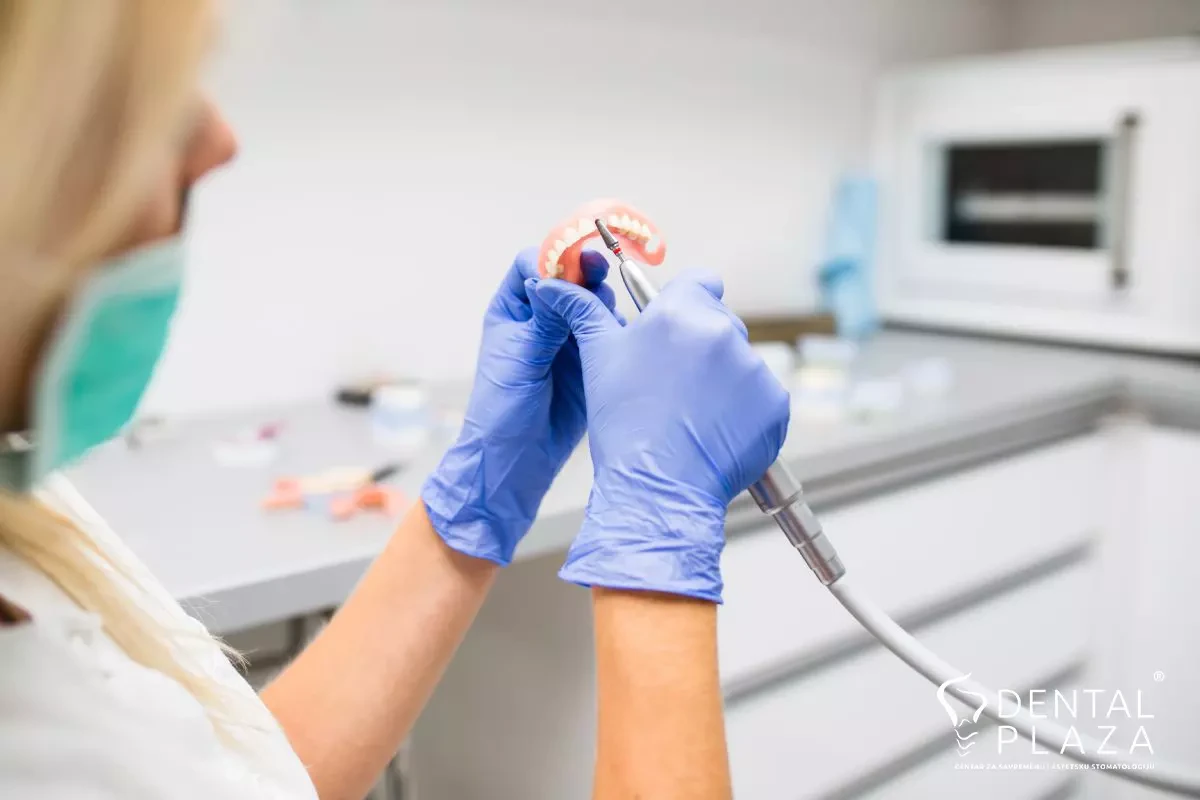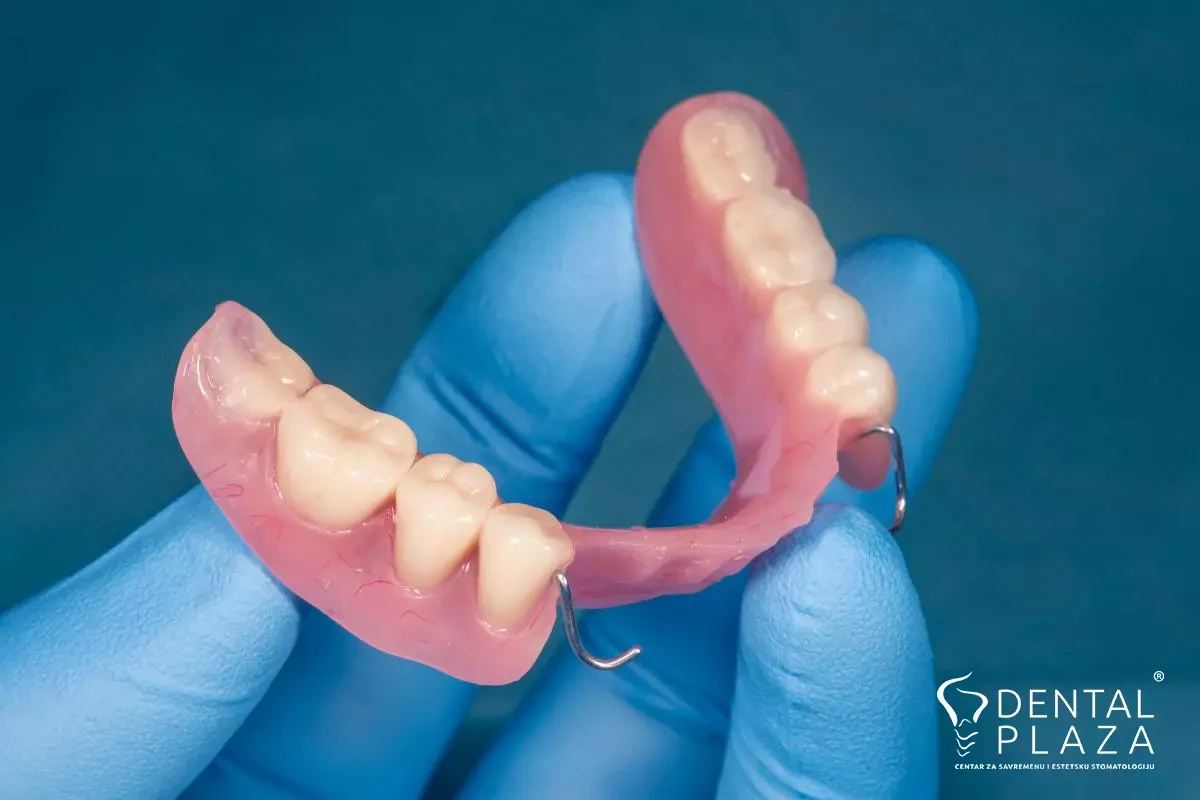Do not be shy, show your teeth!
Call Center 08-21h
Do not be shy, show your teeth!
Call Center 08-21h

A partial denture is a prosthetic replacement that compensates for lost teeth and is fixed to the remaining teeth. It is used as a compensation in toothless patients. A partial denture rests on the gums, covers the alveolar ridge and compensates for lost teeth. All prostheses are made mobile, which means that they can and must be removed from the mouth primarily due to proper maintenance of oral hygiene.
Partial tabular prostheses are certainly the oldest and used for the longest time. They compensate for lost teeth and for worn jawbone, thus re-establishing the normal relationship between the upper and lower jaw, as well as the normal function of the teeth and mouth. It consists of three basic parts: the first one is the part that rests on the jawbone and compensates for its lost part, and is made of acrylic; then artificial teeth that are embedded in acrylate; and finally the part that binds the prosthesis to the remaining natural teeth, which are wire hooks.
The advantage of partial dentures compared to modern therapeutic methods is certainly that it is cheaper and therefore more accessible to a larger number of patients, which increases their quality of life. Unfortunately, the disadvantages of partial dentures are that they are generally very uncomfortable for patients, and the hooks that hold the partial dentures are made of wire, which can lead to receding gums and periodonopathy over time. This is just one of the reasons why partial tabular dentures are only a temporary prosthetic solution.
A partial denture is made during several visits to the dentist. At the beginning, based on impressions of your jaws and other auxiliary templates, the proportions and size of the future teeth are determined. It takes 2-3 visits. After the test of the teeth made in wax, when the final corrections are made, the patient comes to the last appointment where the handing over of the prosthesis itself takes place. Then the patient receives all instructions on its further use. The Dental Plaza team is always available to all of its patients for any concerns they may have later regarding dentures.
It is recommended that partial dentures be only a temporary solution until some definitive prosthetic work is done. The reason for this is their instability, which can lead to loosening of the teeth on which they are fixed and to uneven transfer of forces to the bone.
Partial prostheses serve as a temporary solution for patients immediately after tooth extraction or implant placement, preventing the patient to remain toothless until the moment when definitive prosthetic work is completed. When after some time the tissue changes shape and dimensions in the healing process, the prosthesis should be modified to be adequate for the current situation.

The most commonly used material for making partial dentures is acrylate, and teeth made of the same material are also placed on them. Also, if the partial prosthesis is a definitive prosthetic solution, then acrylate is combined with metal, which additionally strengthens and stabilizes the prosthesis.
Of course. You can choose the color of your teeth, and the dentist is here to offer the best solution in each individual case.
If the partial denture does not fit firmly in the mouth, it is best to consult a dentist. In such situations, you can help yourself with appropriate pharmaceutical means for "gluing" the prosthesis. Also, sometimes it is enough to just slightly tighten the wires that hold the prosthesis, or the dentist will decide on an appropriate correction of the prosthesis.
The chewing process with partial dentures must be bilateral and moderate. Dental Plaza Clinic always emphasizes that it is necessary to take small bites of food and chew on both sides of the jaws. The reason for this is the correct and balanced distribution of forces, which will prevent the prosthesis from moving when eating.
Dentures should be washed at least twice a day and rinsed after meals. Dentures are removed from the mouth and cleaned with a soft brush and low-abrasive toothpaste. In this way, you will degrease the prosthesis and prevent the formation of stones on it. Toothpastes with abrasives can damage the surface of the prosthesis.
.webp)
Dentures should be moved out of the mouth during the night to allow the tissues to rest. Then the prostheses should be placed in a container filled with cold water. Adding baking soda to the top of a teaspoon creates a base environment that prevents fungal growth.
If you notice any instability or cracks while wearing the prosthesis, it is necessary to contact the dentist. The state of the mouth changes over time, so the prosthesis itself must be adjusted. If you have no problems while wearing the prosthesis, it is definitely recommended to contact your dentist for a regular annual check-up.
The price of a partial acrylic prosthesis in the Dental Plaza Clinic is 250e.
Do you have questions?

A partial denture is a prosthetic replacement that compensates for lost teeth and is fixed to the remaining teeth. It is used as a compensation in toothless patients. A partial denture rests on the gums, covers the alveolar ridge and compensates for lost teeth. All prostheses are made mobile, which means that they can and must be removed from the mouth primarily due to proper maintenance of oral hygiene.
Partial tabular prostheses are certainly the oldest and used for the longest time. They compensate for lost teeth and for worn jawbone, thus re-establishing the normal relationship between the upper and lower jaw, as well as the normal function of the teeth and mouth. It consists of three basic parts: the first one is the part that rests on the jawbone and compensates for its lost part, and is made of acrylic; then artificial teeth that are embedded in acrylate; and finally the part that binds the prosthesis to the remaining natural teeth, which are wire hooks.
The advantage of partial dentures compared to modern therapeutic methods is certainly that it is cheaper and therefore more accessible to a larger number of patients, which increases their quality of life. Unfortunately, the disadvantages of partial dentures are that they are generally very uncomfortable for patients, and the hooks that hold the partial dentures are made of wire, which can lead to receding gums and periodonopathy over time. This is just one of the reasons why partial tabular dentures are only a temporary prosthetic solution.
A partial denture is made during several visits to the dentist. At the beginning, based on impressions of your jaws and other auxiliary templates, the proportions and size of the future teeth are determined. It takes 2-3 visits. After the test of the teeth made in wax, when the final corrections are made, the patient comes to the last appointment where the handing over of the prosthesis itself takes place. Then the patient receives all instructions on its further use. The Dental Plaza team is always available to all of its patients for any concerns they may have later regarding dentures.
It is recommended that partial dentures be only a temporary solution until some definitive prosthetic work is done. The reason for this is their instability, which can lead to loosening of the teeth on which they are fixed and to uneven transfer of forces to the bone.
Partial prostheses serve as a temporary solution for patients immediately after tooth extraction or implant placement, preventing the patient to remain toothless until the moment when definitive prosthetic work is completed. When after some time the tissue changes shape and dimensions in the healing process, the prosthesis should be modified to be adequate for the current situation.

The most commonly used material for making partial dentures is acrylate, and teeth made of the same material are also placed on them. Also, if the partial prosthesis is a definitive prosthetic solution, then acrylate is combined with metal, which additionally strengthens and stabilizes the prosthesis.
Of course. You can choose the color of your teeth, and the dentist is here to offer the best solution in each individual case.
If the partial denture does not fit firmly in the mouth, it is best to consult a dentist. In such situations, you can help yourself with appropriate pharmaceutical means for "gluing" the prosthesis. Also, sometimes it is enough to just slightly tighten the wires that hold the prosthesis, or the dentist will decide on an appropriate correction of the prosthesis.
The chewing process with partial dentures must be bilateral and moderate. Dental Plaza Clinic always emphasizes that it is necessary to take small bites of food and chew on both sides of the jaws. The reason for this is the correct and balanced distribution of forces, which will prevent the prosthesis from moving when eating.
Dentures should be washed at least twice a day and rinsed after meals. Dentures are removed from the mouth and cleaned with a soft brush and low-abrasive toothpaste. In this way, you will degrease the prosthesis and prevent the formation of stones on it. Toothpastes with abrasives can damage the surface of the prosthesis.
.webp)
Dentures should be moved out of the mouth during the night to allow the tissues to rest. Then the prostheses should be placed in a container filled with cold water. Adding baking soda to the top of a teaspoon creates a base environment that prevents fungal growth.
If you notice any instability or cracks while wearing the prosthesis, it is necessary to contact the dentist. The state of the mouth changes over time, so the prosthesis itself must be adjusted. If you have no problems while wearing the prosthesis, it is definitely recommended to contact your dentist for a regular annual check-up.
The price of a partial acrylic prosthesis in the Dental Plaza Clinic is 250e.